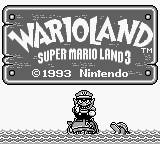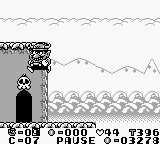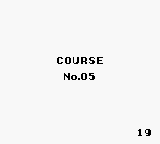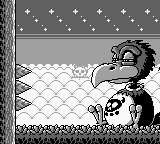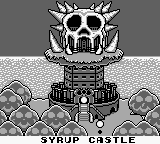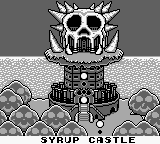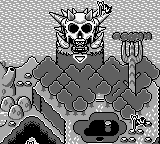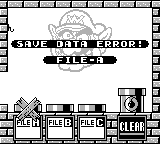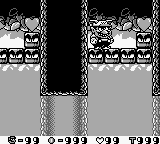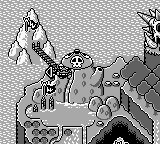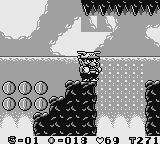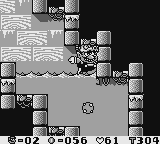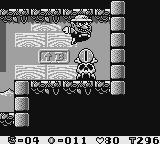Wario Land: Super Mario Land 3
| Wario Land: Super Mario Land 3 |
|---|
|
Also known as: Super Mario Land 3: Wario Land (JP)
|
To do:
|
Wario Land: Super Mario Land 3 is the first game in the Wario Land series and the last game in the Mario Land series. Bitter over his defeat in the previous game, Wario sets out to acquire funds for his own castle by stealing the missing golden Princess Toadstool statue from the Black Sugar Gang so he can hold it for ransom, plundering any other treasure he can get his hands on along the way.
Contents
Sub-Pages
| Prerelease Info |
| Notes |
Debug Modes
Standard Debug Mode
A simple debug mode remains in the game, accessible by pressing Select 16 times while the game is paused. A blinking cursor should appear. Hold B and press Left/Right to move it. Press Up/Down to change the values of your number of lives, coins, hearts, and the timer.
Holding A + B and moving the cursor all the way to the left will highlight the Wario head; unpausing will change your current form (in the order of Small, Normal, Bull, Jet, Dragon). If this action is performed while in the air and A is held down while unpausing, the player can jump again and again, possibly allowing access to normally unreachable areas (such as where the Pouncer in course 4 really ends up going).
(Note that pressing Select a 17th time will make the cursor disappear. However, if you press Select 256 times after the initial 16 presses, the cursor will appear again. This happens because memory address AC85, which stores the Select presses, loops after 256 presses.)
Hidden Debug Mode
A second debug mode is hidden in the game. To enable it, set memory address A8C7 to a non-zero value (Game Genie code 018-C75-E6A or GameShark code 0101C7A8).
In the Course Intro screen a level select is enabled. The level ID is shown in the lower right corner.
Pressing Up/Down will cycle between all the valid level IDs; pressing A or Start enters the level. Note that the level will only be marked as completed if it is located in the same sub-map.
It's also possible to disable debug mode in this screen by pressing Select 10 times.
In a level, pressing Select while the game is not paused will change the current form in the same way the other debug mode does.
If the game is paused:
- Pressing Select will activate a free-roaming mode instead. Use the D-Pad to move Wario around the level. Note that the game checks all the time if the debug mode variable is enabled or not, so disabling the debug mode during this immediately disables free-roaming mode.
- Holding Down + B and pressing Start warps to the ending.
- Pressing Select (16) while the game is paused brings up the other debug mode, with a single difference: highlighting the Wario head clears the level instead of switching between forms.
Unused Graphics
Font
The alphabet used for various hud elements and splash screens has all 26 letters accounted for (plus a few other symbols), however only half of those letters are used in-game.
This also features Mario's head, a leftover from the status bar in Super Mario Land 2.
Alternate Block Tileset
Two generic blocks are unused. The first is an intermediary cracked block that probably would have appeared as Small Wario (you'd have to hit the block two more times to break it), while the second is an alternate version of the skull that appears above stage entrance doors.
| Unused Block Tileset | Used Block Tileset |
|---|---|
They were replaced in the main block tileset with the switch block graphics.
Level Tiles
Sand/Wood Tileset
Ladder tiles using Course 2's main tileset. Interestingly enough, the empty tile is not the one used everywhere else.
Stone Tileset
![]()
Even this spike with unique graphics didn't make the cut.
![]()
Ladder tiles very similar to the ones in Course 2, but with different graphics.
Sherbet Land
| Full | Used |
|---|---|
The frozen platform used in the Sherbet Land boss area has an extra row of tiles that aren't used. The final game opts to use waterline tiles instead, which helps explain how the penguin boss is getting those shell helmets. Shelmets.
![]()
![]()
Those tiles are loaded at the last part of Course 1 but never used.
The last one seems to be a variant of the bottom part of the wooden boards seen on walls.
Parsley Woods
![]()
While these tiles are technically used, the lower half is always obscured by the status bar.
Syrup Castle
![]()
Syrup Castle has no spikes, but plenty of lava.
Final Boss
These tiles should have been put near the bed in the final boss' room, but they aren't.
The lower half of this block is obscured by the status bar. Again.
Unused Bobo Scene
A significant number of tiles relating to Bobo are unused. Note that Syrup Castle is in the background. This makes up a very odd and interesting scene.
- Bobo never sits down.
- The emblem on Bobo's chest is different. The normal emblem has no horns and looks more like a skull.
- It's highly unlikely that Bobo even moved in this arena. The Bobo object actually moves around foreground tiles (a common trick that early Nintendo systems used) that compose the main Bobo body. Here, the background is far too complicated to have Bobo move around without severe graphical glitches.
- The overall design of this room doesn't really match the S.S. Tea Cup. It's possible that the Bobo fight was meant for Parsley Woods.
Map Screen
The majority of these are alternate versions of existing tiles.
Coin Mini-Game
| Unused | Used |
|---|---|
An alternate variation of the round counter. Possibly changed because dark green on a slightly lighter shade of green might have been too difficult to read.
Object Graphics
![]()
Turns out that the Wanderin' Goom may have had an attack at one point! This spitting graphic and projectile are all that remains.
![]()
A little boat that would have appeared in one of the areas in the world map, probably Rice Beach. Wario has serious arm strength.

Seems like the Stove Canyon boss Funfun was going to eat Wario at one point, since he has graphics for moving his tongue and Wario dying as a result.

The ghost boss in Parsley Woods also has graphics for throwing coins, not just spawning them out of thin air. There's an animation showing how they would have worked.
![]()
A pointing gloved hand is loaded in the Treasure Room, stored right next to the sprite for the coin pointer.
Unused Blocks
![]()
There are 3 types of [!] blocks : 32, 38 and 39.
Block 38 is not used in any map. It has its own unused block behaviour code, unused ExActor code for the visual effect when the block is hit, and even saves its state to an otherwise unused variable at A9ED. However, that variable isn't used anywhere else, so activating it does nothing. Additionally, unlike the other [!] blocks, this one isn't in the blacklist for blocks which can't be clinged on with the Bull Hat. As a result, it's possible to cling on it and activate its hit animation continuously.
Unused 16x16 Block Mappings
| To do: This game has a lot of unused blocks. They are perfectly valid even though most display as gibberish (possible leftovers from other tilesets). |
![]()
The generic block isn't used here.
![]()
Platforms that can be jumped through are also completely absent.
Upside-Down Wario
There are multiple copy/pasted variations of the subroutine that draws sprite mappings. The one used for drawing Wario's gameplay sprite happens to not display any vertically-flipped sprite mappings, even though the code to check for them exists and works properly.
This can be seen by setting bit 6 of Wario's sprite flags (0xA916). Wario's sprite mappings were never meant to be displayed this way since their origin is at the bottom of sprite, leading to a a plethora of visual oddities.
Note that the variation used for the Map screen, which is identical code-wise other than for using different addresses, does display vertically-flipped sprites.
Syrup Castle's Flag
When Course 40 is marked as completed, the game displays a flag on top of Syrup Castle. The catch is that the game doesn't go through the normal level clear sequence when beating the final boss, and even if it did, the level is specifically set to not update the submap's completion bits.
The bit can be set anyway by entering what would be Course 39's secondary exit, since secondary exits implicitly use the bit immediately after the one for the normal exit. Course 39 does not have one, however it just so happens that:
- There's a scroll glitch which tricks the camera to move below the level, making the game use out of bounds scroll data. This data corresponds to the one for the next level.
- Going by level IDs, the flooded version of Course 03 immediately follows Course 39
- Course 03 has a secondary exit
- In Course 39's layout, there's a door in the sector where Course 03's secondary exit door would be
The scroll glitch can be triggered by infinite jumping, a side effect of updating Wario's powerup state which can be done at will in Debug Mode.
Note that there's normally unreachable logic that would have started the ending cutscene when Course 40's bit is set, possibly a leftover from a previous iteration of the cutscene. This logic is not meant to be triggered when going through the normal level completion sequence, so it malfunctions:
- Before resetting the game, when attempting to return to the map, the initial part of the ending cutscene will always play, then Course 39 restarts instead of continuing to the Genie scene.
- After resetting the game, the cutscene won't trigger anymore because the game won't see Course 40 as the last cleared level anymore, but the music in the submap is still silenced in preparation for the cutscene.
Save Data Error
When the Save Selection screen is initialized, the game verifies the signature and checksum of each save file. Each save file is stored twice, and it gets immediately wiped out if both copies fail the validation.
Additionally, if exactly one save file is marked as bad, the game displays the message at the right.
Since the message doesn't appear when more than one save file is corrupted, it's very hard to trigger it. The easiest way to pull it off is to abuse glitches that crash the game, but even then chances are that every save file gets corrupted, preventing the message from showing up. Though it can happen when the game's save battery goes bad.
Oddities
Inaccessible Blocks
After draining water from Course 31, some of the heart blocks become inaccessible. To stop Wario from hitting them, programmers put in four invisible blocks, but they're also impossible to hit.
Standing on Mt.Teapot's Bridge
| To do: Move to a Bugs page |
Overworld position (sMapWorldId) A79F:07 is for Mt.Teapot's bridge, which is how the secondary entrance to the Mt.Teapot submap is implemented.
Wario's overworld position is set to that value when exiting Mt.Teapot through Course 08's secondary path, however there is special logic to automatically move Wario to the left when the overworld loads, normally preventing Wario from staying at that location.
Due to a bug, holding B while the overworld loads breaks this logic. This is the only way to allow the left directional arrow to show up on this location.
Specifically, the automatic movement is done by faking a left keypress to the newly pressed keys (which are valid for one frame only), but it forgets to also overwrite the value for the held keys. Holding B on the overworld allows you to look around the map, and the check for that is made before the game checks if Wario wants to move to a particular direction. Since Wario doesn't move when looking around the map, the faked keypress has no effect and gets quickly discarded once the frame ends.
Parsley Woods' Name
The "patch" tilemap with the empty lake also contains an incorrect copy of the zone's name.
| Before | Patch tilemap | After |
|---|---|---|
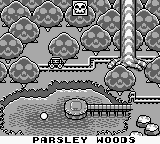
|
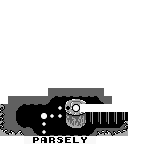
|
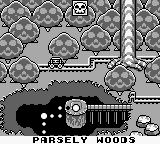
|
In other words, after emptying the lake the zone's name changes.
Invalid tiles
After hitting the [!] block in Course 26, head for the normal exit. In the last part of the level (the one with the crocodiles), there are 4 invalid tiles, as an effect of the [!] block.
Unexpected water tiles
In the next-to-last room of Course 17 (before player jump into the water), there are 4 tiles on the top marked as being underwater when they're not supposed to be. By jumping into the rightmost one and holding A, you can swim indefinitely in the air.
The same glitch exists in Course 01 (flooded). At the end of the level, above the exit door, there is one water tile.
Revisional Differences
Virtual Console Changes
The original Game Boy version had a glitch that made it possible to skip certain levels or worlds on the map screen. The 3DS Virtual Console version fixes this glitch so that it is no longer possible to perform.
The Wario series
| |
|---|---|
| Wario Land | |
| Game Boy (Color) | Wario Land: Super Mario Land 3 • Wario Land II • Wario Land 3 |
| Game Boy Advance | Wario Land 4 |
| GameCube | Wario World |
| Nintendo DS | Wario: Master of Disguise |
| Wii | Wario Land: Shake It! |
| WarioWare Inc. | |
| Game Boy Advance | Mega Microgame$! (Demos) • Twisted! |
| GameCube | Mega Party Game$! |
| Nintendo DS | Touched! (Demo) • D.I.Y. |
| Nintendo DSi | Bird & Beans • Paper Airplane Chase (iQue Prototypes) |
| Wii | Smooth Moves • D.I.Y. Showcase |
| Wii U | Game & Wario |
| Nintendo 3DS | WarioWare Gold |
| Nintendo Switch | Get It Together! • Move It! |
| Miscellaneous | |
| NES | Wario's Woods |
| SNES | Mario & Wario • Wario's Woods |
| Game Boy (Color) | Wario Blast: Featuring Bomberman! |
| See Also | |
| Mario • Rhythm Heaven | |
The Mario series
| |
|---|---|
| NES/FDS | Super Mario Bros. (All Night Nippon) • Super Mario Bros. 2 (FDS) • Super Mario Bros. 2 (NES) (Prototype, Doki Doki Panic) • Super Mario Bros. 3 |
| Game Boy (Color) | Super Mario Land • Super Mario Land 2: 6 Golden Coins • Wario Land: Super Mario Land 3 • Super Mario Bros. Deluxe |
| SNES | Super Mario World (Localization Prototype) • Super Mario All-Stars • Super Mario World 2: Yoshi's Island (Prototypes) |
| Satellaview | BS Super Mario USA • BS Super Mario Collection |
| Nintendo 64(DD) | Super Mario 64 (iQue Prototypes, 64DD Version) |
| Game Boy Advance | Super Mario Advance • Super Mario Advance 2 • Super Mario Advance 3 • Super Mario Advance 4 |
| GameCube | Super Mario Sunshine (Demo) |
| Nintendo DS | Super Mario 64 DS • New Super Mario Bros. |
| Wii | Super Mario Galaxy • New Super Mario Bros. Wii • Super Mario Galaxy 2 • Super Mario All-Stars |
| Nintendo 3DS | Super Mario 3D Land (Demo) • New Super Mario Bros. 2 |
| Wii U | New Super Mario Bros. U (New Super Luigi U) • Super Mario 3D World |
| iOS, Android | Super Mario Run |
| Nintendo Switch | Super Mario Odyssey • New Super Mario Bros. U Deluxe • Super Mario 3D All-Stars • Super Mario Bros. 35 • Super Mario 3D World + Bowser's Fury • Super Mario Bros. Wonder (Kiosk Demo) |
| Game & Watch | Game & Watch: Super Mario Bros. |
| Mario Kart | |
| Console Games | Super Mario Kart (Prototypes) • Mario Kart 64 (iQue Prototype) • Mario Kart: Double Dash!! (Demos, Bonus Disc) • Mario Kart Wii (Mario Kart Channel) • Mario Kart 8 • Mario Kart 8 Deluxe (Prototype) |
| Handheld Games | Mario Kart: Super Circuit • Mario Kart DS (Demos) • Mario Kart 7 • Mario Kart Tour (Closed Beta) |
| Arcade Games | Mario Kart Arcade GP • Mario Kart Arcade GP 2 • Mario Kart Arcade GP DX |
| RPGs | |
| Super Mario RPG | Legend of the Seven Stars (Switch) |
| Paper Mario | Paper Mario • The Thousand-Year Door (Demos, Switch) • Super Paper Mario • Sticker Star • Color Splash • The Origami King |
| Mario & Luigi | Superstar Saga (Prototype, + Bowser's Minions) • Partners in Time • Bowser's Inside Story (+ Bowser Jr.'s Journey) • Dream Team • Paper Jam • Brothership |
| Mario + Rabbids | Kingdom Battle • Sparks of Hope |
| Mario Party | |
| Console Games | Mario Party • Mario Party 2 • Mario Party 3 (Prototype) • Mario Party 4 (Demo) • Mario Party 5 (Demo) • Mario Party 6 (Demo) • Mario Party 7 • Mario Party 8 Mario Party 9 • Mario Party 10 • Super Mario Party • Mario Party Superstars |
| Handheld Games | Mario Party Advance • Mario Party DS • Mario Party: Island Tour |
| Web Games | Mario Party 7: Bowser's Lair Hockey |
| Sports | |
| Golf | NES Open Tournament Golf • Mario Golf (N64, GBC) • Mario Golf: Toadstool Tour • Mario Golf: Advance Tour • Mobile Golf |
| Tennis | Mario's Tennis • Mario Tennis (N64, GBC) • Mario Power Tennis • Mario Tennis: Power Tour (Bicep Pump) • Mario Tennis Aces |
| Strikers | Super Mario Strikers (Demo) • Mario Strikers Charged • Mario Strikers: Battle League |
| Baseball | Mario Superstar Baseball (Mario Baseball Demo) • Mario Super Sluggers |
| Mario & Sonic at the Olympic Games | Beijing 2008 (DS, Wii) • Vancouver 2010 (DS, Wii) • London 2012 • Rio 2016 (Wii U, Arcade) |
| Other | Excitebike: Bun Bun Mario Battle • Mario Pinball Land • Dance Dance Revolution Mario Mix • Mario Sports Mix |
| Dr. Mario | |
| Console Games | Dr. Mario (Prototypes) • Tetris & Dr. Mario • Dr. Mario 64 • Nintendo Puzzle Collection • Dr. Luigi |
| Handheld Games | Dr. Mario • Dr. Mario & Puzzle League • Dr. Mario Express • Dr. Mario World |
| Web Games | Dr. Mario: Vitamin Toss |
| Super Mario Maker | |
| Wii U | Super Mario Maker |
| Nintendo 3DS | Super Mario Maker for Nintendo 3DS |
| Nintendo Switch | Super Mario Maker 2 |
| Mario vs. Donkey Kong | |
| Handheld Games | Mario vs. Donkey Kong (Demo) • March of the Minis (Demo) • Minis March Again! • Mini Land Mayhem! • Tipping Stars • Mini Mario & Friends: amiibo Challenge |
| Console Games | Tipping Stars • Mini Mario & Friends: amiibo Challenge |
| Mario Bros. | |
| Arcade | Mario Bros. |
| NES/FDS | Mario Bros. (Kaettekita) |
| PC-88 | Punch Ball Mario Bros. |
| Virtual Boy | Mario Clash |
| Game Boy Advance | Mario Bros. Classic |
| Mario's Picross | |
| Game Boy | Mario's Picross • Picross 2 |
| SNES | Mario's Super Picross |
| Captain Toad | |
| Wii U | Treasure Tracker |
| Nintendo Switch, Nintendo 3DS | Treasure Tracker |
| Donkey Kong | |
| Arcade | Donkey Kong • Donkey Kong Jr. |
| Atari 8-bit family | Donkey Kong (Prototype) |
| NES/FDS | Donkey Kong • Donkey Kong Jr. |
| Game Boy | Donkey Kong |
| Luigi's Mansion | |
| GameCube | Luigi's Mansion |
| Nintendo 3DS | Dark Moon • Luigi's Mansion |
| Arcade | Luigi's Mansion Arcade |
| Nintendo Switch | Luigi's Mansion 3 • Luigi's Mansion 2 HD |
| Princess Peach | |
| Nintendo DS | Super Princess Peach |
| Nintendo Switch | Princess Peach: Showtime! |
| Adobe Flash | Super Princess Peach: Parasol Fall |
| Wrecking Crew | |
| NES/FDS | Wrecking Crew |
| SNES | Wrecking Crew '98 |
| Art | |
| Console Games | Mario Paint (Prototype) • Mario Artist Paint Studio (Prototype) • Mario Artist Talent Studio • Mario Artist Communication Kit • Mario Artist Polygon Studio I am a Teacher: Super Mario no Sweater • Mario no Photopi |
| Handheld Games | Jaguar Mishin Sashi Senyou Soft: Mario Family • Photos with Mario |
| Educational | |
| Computer Games | Mario is Missing! • Mario's Early Years • Mario Teaches Typing |
| Console Games | Mario is Missing! (SNES, NES) • Mario's Time Machine (SNES, NES) • Mario's Early Years |
| Miscellaneous | |
| Arcade Games | Mario Roulette |
| Computer Games | Mario's Game Gallery |
| Console Games | Mario & Wario • Yoshi's Safari • Undake 30: Same Game Mario Version • Hotel Mario (Prototype) • Super Mario's Wacky Worlds • Fortune Street |
| Handheld Games | Mario Clock • Puzzle & Dragons: Super Mario Bros. Edition |
| Compilations | Donkey Kong, Donkey Kong Jr., Mario Bros. • 3-in-1 Super Mario Bros. / Duck Hunt / World Class Track Meet |
| Competitions | Nintendo World Championships 1990 • Nintendo Campus Challenge 1991 • Nintendo Campus Challenge 1992 • Nintendo PowerFest '94 |
| See Also | |
| Donkey Kong • Game & Watch • Wario • Yoshi | |
- Pages missing developer references
- Games developed by Nintendo R&D1
- Pages missing publisher references
- Games published by Nintendo
- Game Boy games
- Pages missing date references
- Games released in 1994
- Games released in January
- Games released on January 21
- Games released in February
- Games released on February 7
- Games released in May
- Games released on May 13
- Games with unused areas
- Games with unused graphics
- Games with debugging functions
- Games with hidden level selects
- Games with revisional differences
- Pages with a Data Crystal link
- To do
- Wario series
- Mario series
Cleanup > Pages missing date references
Cleanup > Pages missing developer references
Cleanup > Pages missing publisher references
Cleanup > To do
Games > Games by content > Games with debugging functions
Games > Games by content > Games with hidden level selects
Games > Games by content > Games with revisional differences
Games > Games by content > Games with unused areas
Games > Games by content > Games with unused graphics
Games > Games by content > Pages with a Data Crystal link
Games > Games by developer > Games developed by Nintendo > Games developed by Nintendo EPD > Games developed by Nintendo SPD > Games developed by Nintendo R&D1
Games > Games by platform
Games > Games by publisher > Games published by Nintendo
Games > Games by release date > Games released in 1994
Games > Games by release date > Games released in February
Games > Games by release date > Games released in February > Games released on February 7
Games > Games by release date > Games released in January
Games > Games by release date > Games released in January > Games released on January 21
Games > Games by release date > Games released in May
Games > Games by release date > Games released in May > Games released on May 13
Games > Games by series > Mario series
Games > Games by series > Wario series
The Cutting Room Floor > Unimportant Awards > Game Boy games
